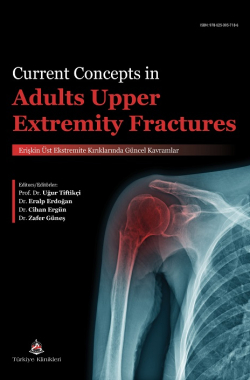CARPAL BONE FRACTURES: CLASSIFICATION AND TREATMENT OPTIONS
Bahadır Can Dağdelen
Ankara Training and Research Hospital, Department of Orthopedics and Traumatology, Ankara, Türkiye
Dağdelen BC. Carpal Bone Fractures: Classification and Treatment Options. In: Tiftikçi U, Erdoğan E, Ergün C, Güneş Z, editors. Current Concepts in Adults Upper Extremity Fractures. 1st ed. Ankara: Türkiye Klinikleri; 2025. p.305-311.
ABSTRACT
The term “carpal” is derived from the Latin word “carpus” and is used to denote the area between the “forearm and wrist”. The term “carpal bones” is a collective designation for a series of eight bones. Of these, there are four in each of the proximal and distal rows. The proximal row comprises the lateral to medial scaphoid, lunate, triquetrum, and pisiform. The distal row consists of the lateral to medial trapezium, trapezoideum, capitatum and hamatum. The principal function of these bones, situated between the metacarpal bones and the radius and ulna bones in the hand, is to facilitate wrist function. The anatomical integrity of the carpal bones and their harmonious interrelation are pivotal for the maintenance of normal wrist function. It is noteworthy that the incidence of carpal bone fractures is comparatively lower when compared to other bone fractures. However, the scaphoid bone, a constituent of the carpal bones, exhibits a distinct pattern. Indeed, scaphoid fractures are more prevalent than other carpal bone fractures. The mechanism of carpal bone fractures is hyperextension; however, it is important to note that fractures may rarely occur with hyperflexion or direct trauma. A detailed history and clinical examination are imperative in patients presenting with wrist pain, swelling and limitation of movement. As carpal bone fractures are frequently under-diagnosed, standard radiographic imaging should be performed in patients presenting with these symptoms. In cases where the diagnostic utility of standard radiography is uncertain, a detailed examination with computed tomography (CT) may be required. Carpal bone fractures, if not correctly diagnosed and treated, can lead to serious complications, chronic pain and functional limitations. While these complications can be prevented with a thorough medical history, detailed physical examination and imaging, complications may still develop depending on the location and blood supply of the carpal bones. The most significant complication is avascular necrosis, which is attributable to the anatomical and blood supply characteristics of the carpal bones. In cases of untreated or delayed carpal bone fractures, impaired blood supply is a potential outcome. The present study commences with a presentation of information regarding the anatomy of the carpal bones, followed by an examination of the mechanisms underpinning fractures within these bones. The subsequent sections of the study will address current treatment methods for carpal bone fractures and the potential complications that may arise during the treatment stages of fractures.
Keywords: Carpal bones; Wrist; Scaphoid bone complications; Hamate bone
Kaynak Göster
Referanslar
- Cansü E. Carpal bone fractures other than scaphoid. TOTBID Journal. 2014;12:159-167. [Crossref]
- Schädel-Höpfner M, Windolf J, Lögters T, et al. Scaphoidfrakturen. Unfallchirurgie, 2023;126(9):799-811. [Crossref] [PubMed]
- Hulsopple C, Deluca J, Jonas C. Treatment of Acute Carpal Bone Fractures. Curr Sports Med Rep. 2017 Sep/Oct;16(5):330-335. [Crossref] [PubMed]
- Hayat Z, Varacallo MA Scaphoid wrist fracture. In StatPearls. StatPearls Publishing.
- Calandruccio HJ. Fractures, Dislocations, and Ligamenteus Injuries of the Hand and Wrist. In: Azar FM, Canale ST, Beaty JH (Eds) Campbell's Operative Orthopaedics. 2020;14:3518
- Cavalcanti Kußmaul A, Kuehlein T, Langer MF, Ayache A, Löw S, Unglaub F. The Conservative and Operative Treatment of Carpal Fractures. Dtsch Arztebl Int. 2024 Sep 6;121(18):594-600. [Crossref] [PubMed] [PMC]
- Camus EJ, Van Overstraeten L. Kienböck's disease in 2021. Orthop Traumatol Surg Res. 2022 Feb;108(1S):103161. [Crossref] [PubMed]
- Abrego MO, De Cicco FL. Hamate fractures. In StatPearls. StatPearls Publishing. 2019.
- Guo RC, Cardenas JM, Wu CH. Triquetral Fractures Overview. Curr Rev Musculoskelet Med. 2021 Apr;14(2):101-106. [Crossref] [PubMed] [PMC]
- Price MB, Vanorny D, Mitchell S, Wu C. Hamate Body Fractures: a Comprehensive Review of the Literature. Curr Rev Musculoskelet Med. 2021 Dec;14(6):475-484. [Crossref] [PubMed] [PMC]
- Wright TW, Moser MW, Sahajpal DT. Hook of hamate pull test. J Hand Surg Am. 2010 Nov;35(11):1887-9. [Crossref] [PubMed]
- Cooney AD, Stuart PR. Symptomatic nonunion of an isolated capitate fracture in an adolescent. J Hand Surg Eur Vol. 2013 Jun;38(5):565-7. [Crossref] [PubMed]
- Colizzi M, Amadei F, Marcuzzi A, Grassi FA, Leigheb M. Current concepts about carpal traumatology. Chirurgia 2023;36:281-5. [Crossref]
- Geissler WB, Slade JF. Fractures of the carpal bones. In Wolfe SW, Hotchkiss, Pederson WC, Kozin SH (Eds.). Green's operative hand surgery. Churchill Livingstone Elsevier. 2011;6:639-707 [Crossref]
- Schädel-Höpfner M, Prommersberger K, Eisenschenk A, et al. Behandlung von Handwurzelfrakturen. Unfallchirurg. 2010;113(9):741-756. [Crossref] [PubMed]

